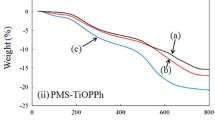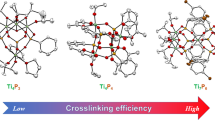Abstract
Two analogous inorganic-organic hybrids with a phyllosilicate-like structure SILMgl and SILMg2, containing 3-aminopropyl- and N-propylethylenediaminetrimethoxysilane were synthesized through a sol-gel process. These hybrids adsorbed divalent cations of cobalt, nickel, copper, and zinc from aqueous solution to give the effectiveness of adsorption capacities in the sequence Cu2+ > Zn2+ > Ni2+ > Co2+. SILMgl has a higher capacity of adsorption than SILMg2. Elemental analysis, X-ray diffractometry, thermal analysis, infrared and nuclear magnetic resonance spectroscopies, and energy dispersive system microscopy characterized all hybrids. The proposed adsorption mechanism involves dissolution of the precursor matrix, formation of a phyllosilicate around the adsorbed ion, and a complexation of the cation by the amino-pendant groups in the interlayer. These new phyllosilicates are more crystalline than the original hybrids. The adsorption of Co2+ increases the interlayer distance to maximum values of 1.81 and 2.24 Å for SILMg1 and SILMg2, respectively. Thermal analysis data showed a decrease of thermal stability with cation adsorption. Si-O-Si groups were detected by infrared spectroscopy in all hybrids and a band at 1384 cm1 was assigned to the nitrate counter anion, which indicates the participation of this ion in the sphere of coordination of the interlayer complexes. The photomicrographs obtained by scanning electron microscopy showed the organized distribution of the sheet structure for these synthesized phyllosilicates.
Similar content being viewed by others
References
Bem-Naim, A. (1987) Solvation Thermodynamics. Plenium Press, New York, 246 pp.
Blinker, C.J. and Scherer, G.W. (1990) Sol-Gel Science-The Physics and Chemistry of Sol-Gel Processing. Academic Press, New York, 908 pp.
Burkett, S.L., Press, A., and Mann, S. (1997) Synthesis, characterization and reactivity of layered inorganic-organic nanocomposites based on 2:1 trioctahedral phyllosilicates. Chemical Materials, 9, 1071–1073.
Carrado, K.A. and Langqiu, X. (1999) Materials with controlled mesoporosity derived from synthetic polyvinylpyrrolidone-clay composites. Microporous and Mesoporous Materials, 27, 87–94.
Cestari, A.R. and Airoldi, C. (1997) Chemisorption on thiolsilicas: Divalent cations as a function of pH and primary amines on thiol-mercury adsorbed. Journal of Colloid and Interface Science, 195, 338–342.
Decarreau, A. (1985) Partitioning of divalent elements between octahedral sheets of trioctahedral smectites and water. Geochimica et Cosmochimica Acta, 49, 1537–1544.
Decarreau, A., Grauby, O., and Petit, S. (1992) The actual distribution of octahedral cations in 2:1 clay minerals: Results from clay synthesis. Applied Clay Science, 7, 147167.
De Vynck, I. (1980) Synthese de phyllosilicates de cobalt, de nickel, de cuivre et de zinc. Silicates Industriels, 3, 51–66.
Farias, R.F. and Airoldi, C. (2000) Effect of addition of divalent transition metal chlorides on the structure and thermal stability of lamellar silica synthesized by neutral amine route. Journal of Solid State Chemistry, 149, 113–119.
Farmer, V.C. (1964) The infrared spectra of layer silicates. Spectrochimica Acta, 20, 1149–1173.
Fonseca, M.G., Silva, C.R., and Airoldi, C. (1999) Aminated phyllosilicates synthesized via a sol-gel process. Langmuir, 15, 5048–5055.
Fukushima, Y. and Tami, M. (1995) An organic/inorganic hybrid layered polymer: Methacrylate-magnesium(nickel) phyllosilicate. Chemical Communications, 241–242.
Fukushima, Y. and Tami, M. (1996) Synthesis of 2:1 type 3- (methacrylate)propyl magnesium(nickel) phyllosilicate. Bulletin of the Chemical Society of Japan, 69, 3667–3671.
Hong, Y-S. and Kim, S-J. (1997) A layered phyllosilicate compound containing l, 12-diaz-3, 4:9, 10-dibenzo-5, 8-diox- acyclopentadecane. Bulletin of the Korean Chemical Society, 18, 236–239.
Kadkhodayan, A., Chi-Li, L., and Pinnavaia, T.J. (1988) Chemical modification of the gallery surfaces in layered silicate clays (LSC’s) for catalytic applications in nucleophilic displacement reactions. In Chemically Modified Surfaces in Science and Industry, D.E. Leyden and W.T. Collins, eds., Gordon and Breach Science, London, 221–238.
Krestov, G.A. (1991) Thermodynamics of Solvation: Solution and Dissolution; Ions and Solvents; Structure and Energetics. Ellis Horwood, London, 284 pp.
Komarneni, S., Kozai, N., and Roy, R. (1998) Novel function for anionic clays: Selective transition metal cation uptake by diadochy. Journal of Material Chemistry, 6, 1329–1331.
Lishko, T.P., Glushchenko, L.V., Kholin, Y.V., Zaitev, Z.N., Bugaevskii, A., and Donskaya, N.D. (1991) Complexation on silica gels chemically modified by amines of various denticity. Russian Journal of Physical Chemistry, 65, 1584–1588.
Mizutani, T., Fukushima, Y., Okada, A., and Kamigaito, O. (1990) Synthesis of nickel and magnesium phyllosilicates with 1:1 and 2:1 layer structures. Bulletin of the Chemical Society of Japan, 63, 2094–2098.
Mosser, C., Mestdagh, M., Decarreau, A., and Herbilion, A.J. (1990) Spectroscopic (ESR, EXAFS) evidence of Cu for (Al-Mg) substitution in octahedral sheets of smectites. Clay Minerals, 25, 271–281.
Nakamoto, K. (1986) Infrared Spectra of Inorganic and Coordination Compounds. John Wiley and Sons, New York, 484 pp.
Newman, A.C.D. and Brown, G. (1980) The chemical constitution of clays. In Crystal Structures of Clay Minerals and Their X-ray Identification, G.W. Brindley and G. Brown, eds., Mineralogical Society, London, 1–128.
Pavia, D.L., Lampman, G.M., and Kriz, G.S. (1996) Introduction to Spectroscopy: A Guide for Students of Organic Chemistry. Saunders College Publishing, Orlando, 511 pp.
Pinnavaia, T.J. (1983) Intercalated clay catalysts. Science, 220, 365–371.
Rayner, J.H. and Brown, G. (1973) The crystal structure of talc. Clays and Clay Minerals, 21, 103–144.
Silva, C.R. and Airoldi, C. (1997) Acid and base catalysts in the hybrid silica sol-gel process. Journal of Colloid and Interface Science, 195, 381–387.
Silverstein, R.M., Bassler, G.C., and Morrel, T.C. (1991) Spectrometric Identification of Organic Compounds. John Wiley and Sons, London, 387 pp.
Ukrainczyk, L., Bellman, R.A., and Anderson, A.B. (1997) Template synthesis and characterization of layered Al- and Mg-silsesquioxanes. Journal Physical Chemistry B, 101, 531–539.
Velde, B. (1992) Introduction to Clay Minerals. Chapman and Hall, London, 198 pp.
Wesolowski, M. (1984) Thermal decomposition of talc: A review. Thermochimica Acta, 78, 395–421.
Whilton, N.T., Burkett, S.L., and Mann, S. (1998) Hybrid lamellar nanocomposites based on organically functionalized magnesium phyllosilicate clays with interlayer reactivity. Journal of Material Chemistry, 8, 1927.
Wilkins, R.W.T. and Ito, J. (1967) Infrared spectra of some synthetic talcs. American Mineralogist, 52, 1649–1661.
Yang, J.J., El-Nahhal, I.M., I-Ssuer, C., and Maciel, G.E. (1997) Synthesis and solid-state NMR structural characterization of polysiloxane-immobilized amine ligands and their metal complexes. Journal of Non-Crystalline Solids, 209, 19–39.
Xiang, Y. and Villemure, G. (1996) Electrodes modified with synthetic clay minerals: Electrochemistry of cobalt smectites. Clays and Clay Minerals, 44, 515–521.
Xiao, J. and Villemure, G. (1998) Preparation, characterization and electrochemistry of synthetic copper clays. Clays and Clay Minerals, 48, 195–203.
Author information
Authors and Affiliations
Corresponding author
Rights and permissions
About this article
Cite this article
Da Fonseca, M.G., Barone, J.S. & Airoldi, C. Self-Organized Inorganic-Organic Hybrids Induced by Silylating Agents with Phyllosilicate-Like Structure and the Influence of the Adsorption of Cations. Clays Clay Miner. 48, 638–647 (2000). https://doi.org/10.1346/CCMN.2000.0480605
Received:
Accepted:
Published:
Issue Date:
DOI: https://doi.org/10.1346/CCMN.2000.0480605




